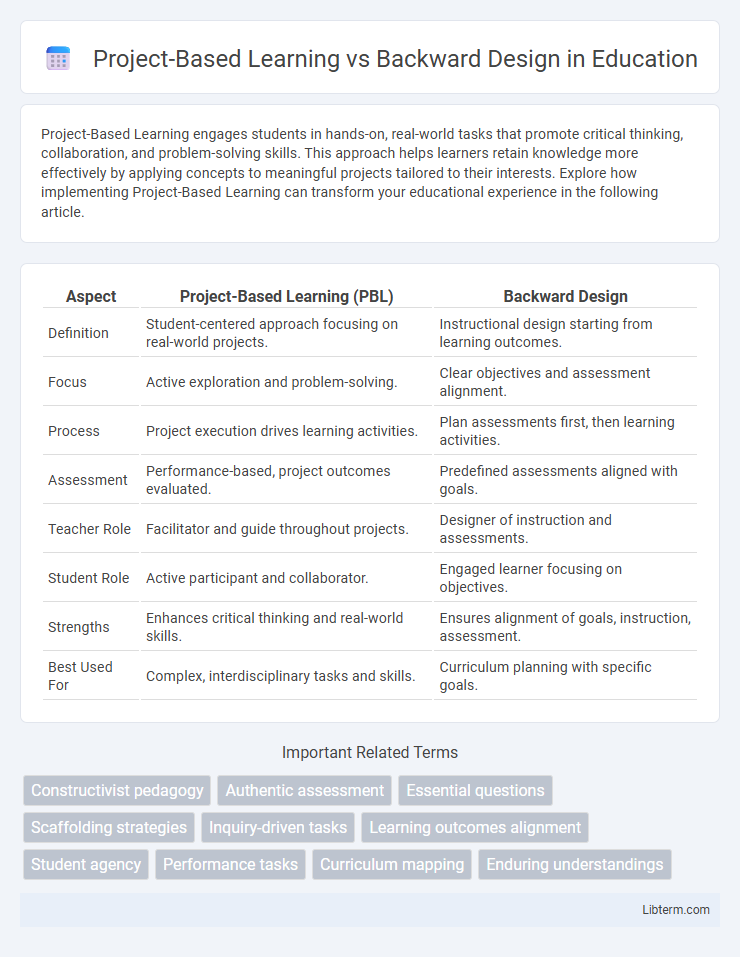Project-Based Learning engages students in hands-on, real-world tasks that promote critical thinking, collaboration, and problem-solving skills. This approach helps learners retain knowledge more effectively by applying concepts to meaningful projects tailored to their interests. Explore how implementing Project-Based Learning can transform your educational experience in the following article.
Table of Comparison
| Aspect | Project-Based Learning (PBL) | Backward Design |
|---|---|---|
| Definition | Student-centered approach focusing on real-world projects. | Instructional design starting from learning outcomes. |
| Focus | Active exploration and problem-solving. | Clear objectives and assessment alignment. |
| Process | Project execution drives learning activities. | Plan assessments first, then learning activities. |
| Assessment | Performance-based, project outcomes evaluated. | Predefined assessments aligned with goals. |
| Teacher Role | Facilitator and guide throughout projects. | Designer of instruction and assessments. |
| Student Role | Active participant and collaborator. | Engaged learner focusing on objectives. |
| Strengths | Enhances critical thinking and real-world skills. | Ensures alignment of goals, instruction, assessment. |
| Best Used For | Complex, interdisciplinary tasks and skills. | Curriculum planning with specific goals. |
Introduction to Project-Based Learning and Backward Design
Project-Based Learning (PBL) is an instructional strategy that engages students in exploring real-world problems through collaborative projects, fostering critical thinking and creativity. Backward Design is a curriculum planning approach that starts with identifying desired learning outcomes and then designing assessments and instructional activities to achieve those goals. Integrating PBL with Backward Design ensures that projects are aligned with clear educational objectives and measurable student outcomes.
Defining Project-Based Learning: Key Principles
Project-Based Learning (PBL) centers on engaging students in real-world, meaningful projects that promote critical thinking, collaboration, and problem-solving skills through active inquiry and sustained investigation. Key principles include student-driven questions, interdisciplinary content integration, and authentic assessment that reflects both the process and the product of learning. PBL fosters deep understanding by connecting academic standards to practical applications, encouraging reflection and revision throughout the learning journey.
Understanding Backward Design: Core Concepts
Backward Design centers on planning educational activities by first defining desired learning outcomes and then identifying assessment methods before developing instructional strategies. This approach ensures alignment between objectives, assessments, and teaching methods, promoting deeper understanding and retention of knowledge. By prioritizing clear goals and measurable outcomes, educators can create focused, effective curricula that enhance student learning experiences.
Comparing Learning Outcomes: PBL vs Backward Design
Project-Based Learning (PBL) emphasizes hands-on, experiential learning that fosters critical thinking, collaboration, and real-world problem-solving skills, leading to deeper understanding and retention. Backward Design prioritizes clearly defined learning outcomes and assessments first, ensuring alignment between objectives and instructional activities, resulting in targeted mastery of subject matter. Comparative studies reveal that PBL enhances creativity and engagement, while Backward Design improves knowledge retention and measurable academic performance.
Curriculum Planning: Process Differences
Project-Based Learning (PBL) centers curriculum planning around student-driven projects that integrate real-world problems, fostering active inquiry and collaboration. Backward Design starts with defining desired learning outcomes and assessments, then structures the curriculum to systematically achieve specific educational goals. The primary process difference lies in PBL's emphasis on exploratory learning through projects, whereas Backward Design prioritizes goal-oriented sequencing and alignment of instruction to predetermined objectives.
Assessment Strategies: Authentic vs Goal-Oriented
Project-Based Learning emphasizes authentic assessment strategies that evaluate students' ability to apply knowledge in real-world contexts through complex, hands-on projects. Backward Design centers on goal-oriented assessments, developing evaluation methods directly aligned with predetermined learning objectives and standards. These distinct approaches impact how educators measure student understanding and skills, balancing practical application with targeted outcomes.
Student Engagement and Motivation
Project-Based Learning (PBL) enhances student engagement by immersing learners in real-world challenges that foster creativity and critical thinking, driving intrinsic motivation through meaningful, hands-on experiences. Backward Design aligns curriculum goals with assessment and instruction, ensuring clarity and purpose, which supports motivation by providing students with clear expectations and a sense of progress. Combining PBL with Backward Design maximizes engagement by creating targeted, relevant projects that connect learning outcomes to student interests and achievements.
Teacher Roles and Facilitation Styles
Project-Based Learning (PBL) requires teachers to act as facilitators who guide student inquiry, encourage collaboration, and adapt to evolving project needs, emphasizing a student-centered approach. In contrast, Backward Design positions teachers as curriculum planners who define clear learning goals first, then develop assessments and instructional strategies aligned with those objectives, resulting in a more structured facilitation style. Both pedagogies demand dynamic teacher roles, but PBL focuses on fostering autonomy and creativity, while Backward Design prioritizes intentional planning and outcome-driven instruction.
Challenges and Limitations of Each Approach
Project-Based Learning often faces challenges related to time management and resource allocation, as its open-ended nature requires significant planning and student autonomy, which can lead to inconsistent outcomes. Backward Design can be limited by its rigid structure, potentially stifling creativity and failing to accommodate diverse learning styles or emergent student interests. Both approaches demand skilled educators to balance flexibility with curriculum goals, highlighting the need for professional development and adaptive instructional strategies.
Choosing the Right Approach: Practical Considerations
Project-Based Learning emphasizes student-driven inquiry and real-world problem solving, making it ideal for fostering creativity and collaboration in hands-on environments. Backward Design starts with clearly defined learning objectives and assessment criteria, ensuring alignment and focus throughout the instructional process, which benefits courses requiring mastery of specific skills or knowledge. Educators should evaluate factors such as curriculum goals, student needs, available resources, and desired outcomes to select the most effective approach for their teaching context.
Project-Based Learning Infographic

 libterm.com
libterm.com